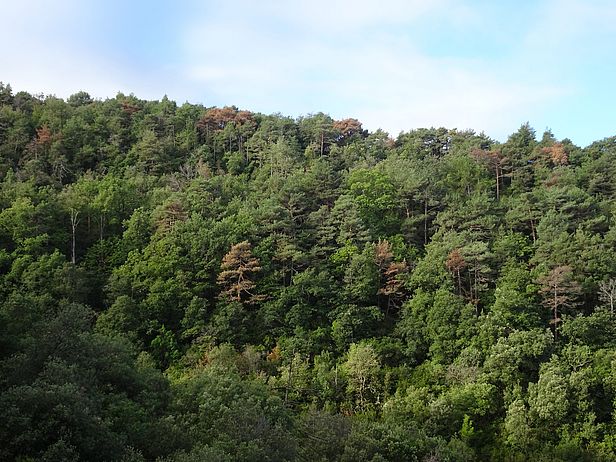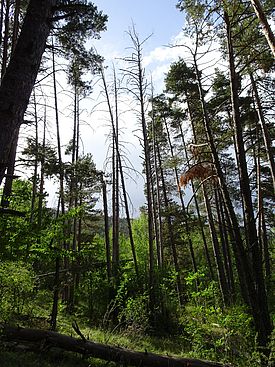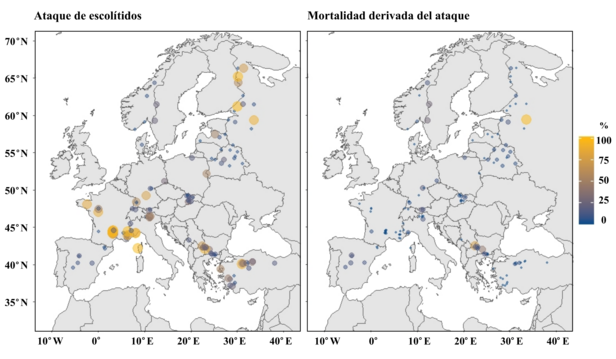08.04.2022 | CREAF | News WSL
A study led by CREAF, the Swiss Federal Institute for Forest, Snow and Landscape Research WSL and the Autonomous University of Barcelona reveals that exposure to drought determines whether a tree will resist attack by pests. The more droughts it has suffered, the more likely it is to die if attacked by certain insects.
- The research has studied coniferous forests across Europe over the last 10 years and found that ca. 30 per cent of trees are affected by a forest pest and six per cent have been killed.
- The coniferous forests that are being most affected and may be most in the future are those in the centre, north and south-east of the continent.
The scientific community has already shown that forests growing in a climate unsuitable for them, such as a spruce in a dry climate, are easily more affected by forest diseases or pest attacks. However, according to the article recently published in Global Change Biology ‘Climatic and stand drivers of forest resistance to recent bark beetle disturbance in European coniferous forests’, climate change is making it possible for even forests living in their most optimal environment to be affected by bore beetle infestation.
The research team is made up of CREAF researchers Luciana Jaime González (first author) and Enric Batllori; Francisco Lloret, professor of ecology at the Autonomous University of Barcelona and CREAF researcher, and Marco Ferretti, head of the research unit Forest Resources and Management at the Swiss Federal Institute for Forest, Snow and Landscape Research (WSL).
Drought is the main cause of this situation. The article concludes that major heat waves and accompanying droughts put forests at the limit of their resilience and expose them to insect attack. This mixture is the trigger that causes pest mortality in large forest stands. "According to the results of the research, the resistance of a forest to attack by these insects depends almost exclusively on the drought and its intensity and duration," explains Luciana Jaime González. "Moreover, the effects are cumulative: forests have a memory and the more droughts their history includes, the more likely they are to succumb.
Global warming is encouraging more and higher development of some forest pests, such as the pine borer beetles of the genera Tomicus and Ips, and at the same time, it is causing more intense droughts. According to Luciana Jaime González, the result of this combination is a lethal cocktail for conifers: "Of the thousands of trees studied, almost 30% are infested by a scolytid, the family of boring beetles that most frequently attacks them, and 6% have already died".
European forests at risk ¶
In recent years, the number of coniferous forests in Europe that have died directly or from causes associated with insect attacks has increased worryingly. For this reason, this study led by CREAF and the Autonomous University of Barcelona, has investigated 130 ICP Forests plots across Europe monitored since 2010 to understand how trees respond to insect attack and which are the most exposed. The research has found that central, northern and south-eastern Europe are the areas where the pests are becoming more aggressive and infesting more forests. In particular, the scolytid species that are causing the most problems are those that complete more than one life cycle per year, known as multivoltines, because they take advantage of rising temperatures to reproduce more and more times per year. These data, "are very important to generate risk maps and hot spots where scolytds will be more favoured by high temperatures and associated droughts and can put the integrity of the forest at risk," according to Luciana Jaime González.
In addition to drought and temperature, there are also other factors that predispose trees to attack by these insect pests, such as the structure of the forest itself and the forest species composition.
Original press release CREAF: https://blog.creaf.cat/en/noticies-en/forest-pests-are-becoming-increasingly-aggressive-because-of-global-warming/
Contact ¶
Adriana Clivillé
CREAF International communications
a.cliville(at)creaf.uab.cat
Tel: +34 62 7 260 2 87
Publications ¶
Links ¶
Copyright ¶
WSL and SLF provide the artwork for imaging of press articles relating to this media release for free. Transferring and saving the images in image databases and saving of images by third parties is not allowed.



